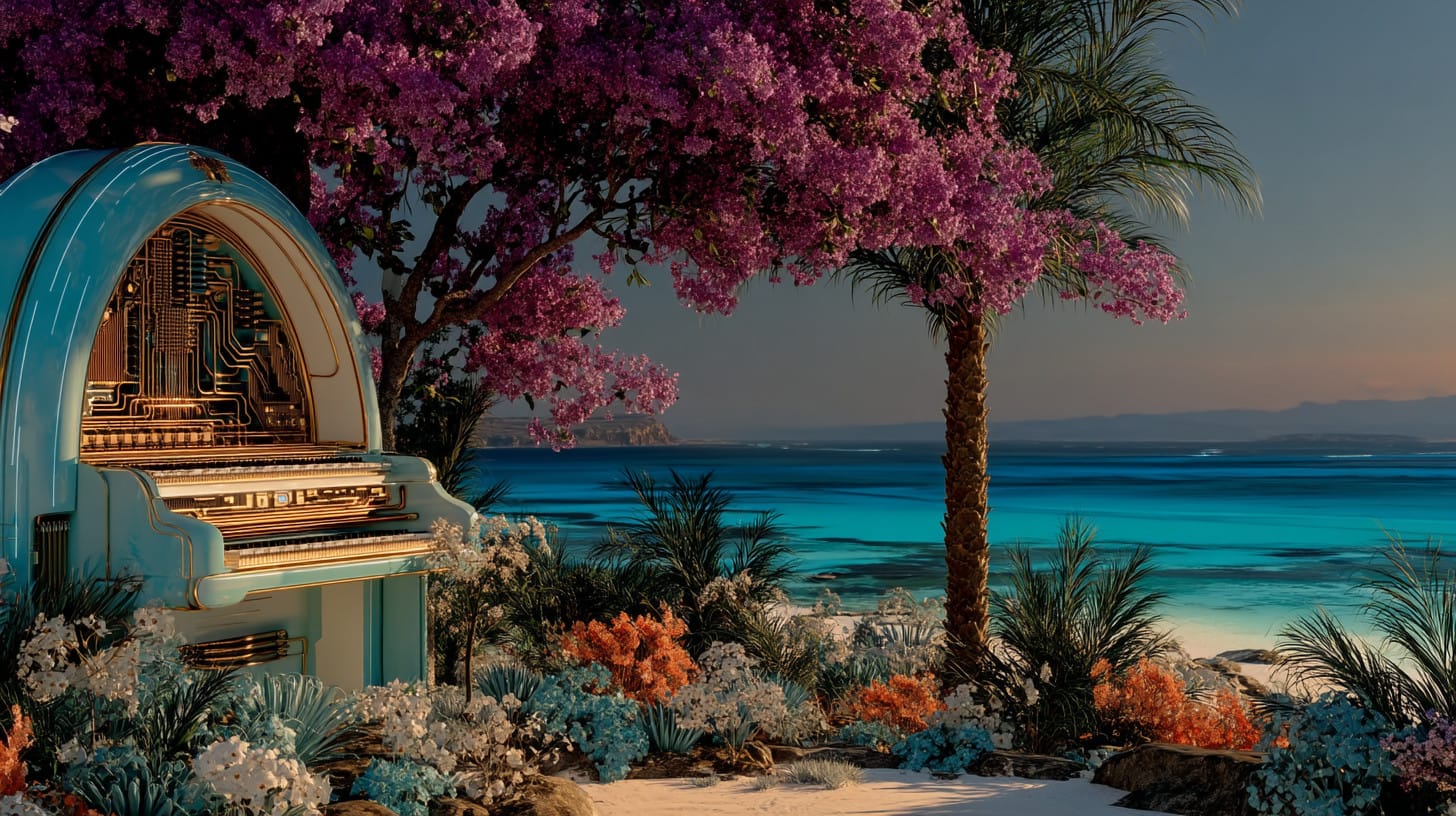Making Waves in Uncharted Waters: AI Music’s Brave New World

I first met Ola in 2002 when we co-organized Whippit, an electro night in Toronto’s underground music scene. She was the resident visual artist, and I quickly developed a deep respect for her creative vision. From experimental film, video, and installation, to performance art, Ola (her current artist name) pushed boundaries and found new ways to express complex ideas through art. Today, we continue working closely together as designers, but this conversation explores a different side of her creative practice—one that ventures into the uncharted territory of AI-generated music.
The sound of waves crashing mingles with Ola’s voice as we sit on a Costa Rican beach, escaping the Canadian winter for a few months of remote work under palm trees. It might seem like an odd setting for a conversation about artificial intelligence and the future of music, but Ola’s relationship with AI is complicated.
“Pop music is like a religion,” she tells me, her voice carrying conviction as a frigate bird circles overhead. “We’ve all been thoroughly brainwashed by it and continue to be brainwashed by it. I think it’s the best way to undo the bad brainwashing and redo it with really helpful, wholesome things.”
It’s a bold statement from someone who describes herself as “really freaked out” by artificial intelligence and thinks it’s “moving too fast.” Yet here she is, spending precious spare time when she's not working at her day-job as a UX designer, making music with AI that emerges from a genuine curiosity about what these new tools can create, and an aspirational goal of creating music that might help humanity “do well together as a species” instead of “killing each other and destroying the planet.”
Ola embodies the contradictions many of us feel about AI right now. She’s simultaneously amazed and terrified, finding creative liberation through tools she fundamentally distrusts. Her story offers a window into what happens when ideology meets reality in an era where machines can mimic creative output, and it reveals just how complicated the act of making music with AI can be.
Pajarito is a fresh bossa-vibe track in Spanish and English with vintage analog grooves. Made on her birthday, it was inspired by little tropical birds making a nest high up in a tree outside her window, where occasional hawks would fly overhead.
A Personal Path to Music
Music has been Ola’s companion for much of her life: her father was in a rock band when she was a child and built a recording studio in their basement; during her teenage years she was a club kid obsessed with alternative and electronic music; while studying fine arts in university she worked at the city’s biggest music store. Later, she channeled her passion into visual installations and live performances at underground music events, always drawn to the intersection of sound and experience.
Despite this deep musical background, she never played an instrument well and considered herself an average singer. “I was very musical and had a lot of ideas,” she explains. “I even wrote a lot of little songs, and have lots of little ditties in all sorts of nooks and crannies.” But translating those ideas into finished pieces wasn’t feasible until AI gave her a completely new kind of instrument.
“I’m making music for fun and as personal therapy,” she tells me, her voice carrying both warmth and clarity. “And also to share it with the world.”
Ola has always loved experimenting and learning, and appreciates how AI tools like ChatGPT and Udio allow her to explore and create. When she wanted help learning Spanish verbs in the past tense she made “Vivir y Aprender,” a 90s hip-hop track that exceeded her expectations: “I got a lot of help with the lyrics on that one because my Spanish no es perfecto. It was remarkable what a good language assistant and rapper AI can be.”
Even her musician father, sometimes skeptical of her musical tastes, “absolutely loves it and wants to do his own version of it.” And she loves the idea of musicians doing their own cover versions of her songs with real instruments and vocals.
An uplifting and funky 90s-style hip hop track that’s also great for learning Spanish verbs in the past tense. For English subtitles turn on Closed Captions (CC) in the YouTube player.
Swimming Against a Digital Tide
This personal approach to AI music creation stands in stark contrast to what’s currently flooding streaming platforms. Deezer now receives over 20,000 fully AI-generated tracks every day—that’s 18% of all new music uploads, and nearly double the 10% reported just four months earlier. “It’s overwhelming,” Ola admits, reflecting on the numbers. “I’m contributing to this flood, but I’m trying to make sure what I add actually means something, has good vibes, and sounds great.”
The scale and sometimes deceptive nature of AI music generation has prompted dozens of musicians, including Billie Eilish, Nicki Minaj and Stevie Wonder, to warn that AI-generated music trained using their work could “sabotage creativity” and sideline human artists. Their concerns seem validated by cases like The Velvet Sundown, a band that gained over 470,000 monthly Spotify listeners while being deceptive about its use of AI, not that all of those listeners necessarily cared. Music manufactured for popularity is hardly new after all.
So it's fitting that "Blueberry Fields"—her first published EP—is a tribute to the age-old practice of remixing and riffing off of popular music, while also alluding to the surreal time we're living in. It's a collection of six songs that all contain the same lyrics, yet each one is produced in a completely different genre. Even the album art is self-referrential, incorporating a tongue-in-cheek misspelling and faux pixellation in the title.
A chill acoustic indie song inspired by the past, present, and future… with a nod to the well-known Beatles hit and the latest technology that’s been rocking the world and transforming creativity.
The Reality of AI Collaboration
For those curious about the technical side, Ola’s process reveals that AI music creation involves far more than pushing a button and getting a hit song. While she may have a clear idea in her head when she sits down to create something new, the technology requires being open to flexibility and serendipity in the process.
“It has its own quirks and a different creative process, more like working with samples, synths and software but weirder and more random. Sometimes it will even invent its own words and I’m a fan of that—Damo Susuki was great at that. You can hear it in my song Blueberry Disco.”
Her songs often start with an insight: “The insights happen away from computers and they’re related to real life experiences,” she tells me. She’ll then dig into that concept, sometimes collaborating with ChatGPT to help develop the lyrics, asking it to “make this into a rap song” or “give me ten versions of this word that rhyme, but have a more encouraging vibe.” There are many iterations and edits before it’s ready to start working with.
Then comes the technical work. Using Udio, an AI music generation platform, she’ll take her lyrics and start the cycle of “generating and assessing, generating and assessing.” She might need to tweak her prompts, change her lyrics and instructions, edit genre tags, or try negative prompting to exclude unwanted elements like horns or vocals—though she notes these exclusions “don’t always work. Sometimes it does the opposite.”
The most maddening part comes during the assembly process. Since Udio generates music in either 30-second or 2-minute increments, creating a full song means stitching together pieces while listening to the same snippets “over and over and over and over.” And once a song is structurally complete there’s often inpainting (i.e., regenerating) parts of the song that need tweaking or changing, along with cropping, extending, or shortening… it can be a fiddly and drawn out process.
A single song might take months to complete, as she often needs to step away, get a break from it, and focus on other commitments. There’s also the album artwork to consider, song titles to obsess over, and final mastering to ensure the sound levels are balanced. Then there’s putting it up on the platforms, and ideally promoting it on social media, though she doesn’t do that as much as she thinks she should: “Im a busy person, I’d rather be making songs.”
A dreamy and gentle reminder to take your time, wrapped in a lush and chill down-tempo vibe. She made this song for herself—and for everyone else who feels like they are always rushing—as an invitation to slow down and savour life.
The Social Media Dilemma
Beyond any potential legal concerns associated with AI-generated music—Udio and Suno are currently being sued by the major labels for copyright infringement—Ola worries about public reception. “There’s this vibe of hating on AI that’s going on right now,” she notes, while considering how to share her music without inviting controversy.
Some platforms now require creators to declare if content is AI-generated, partly due to concerns about misinformation and deepfakes. It also prevents her music from being monetized on certain platforms like Instagram and TikTok, despite those platforms being rife with AI-generated content.
For now, she’s decided to keep a low profile. Sharing her music with close friends and family, and engaging in some light promotion on Bluesky, allows her music a chance to spread organically, if slowly. Eventually, the hope is, people will come to appreciate her songs for their vibe and their message, and it won’t matter what tools she uses to create them.
Finding Harmony in the Chaos
Ola’s story reveals AI music creation as neither the effortless magic promised by tech evangelists nor the creative apocalypse feared by traditionalists. For her, it’s a personal journey that requires artistic vision, technical patience, and thoughtful consideration of how to share authentic expression in a complicated landscape.
“AI is affecting me too, and I’m nervous about how it will all unfold. I think it’s moving too fast and we need to be more responsible, caring and collaborative with how we develop and integrate it.”
Her months-long song-making sessions, careful attention to emotional authenticity, and wrestling with ethical implications aren’t the actions of someone lazily automating creativity. They’re the practices of an artist using new tools for the oldest human reasons: to process experience, find joy, and connect with others.
Back in Canada now, Ola continues creating music and now has a backlog of inspiring songs to release, but she’ll put them out when she’s ready, and with intention.
“We need to be gentle and make it fun,” she explains of her approach to creating positive content. “Finding wonderful ways to help people feel better is the way to go, and music is a great way to do it.”
You can find Ola on all the major streaming platforms including Spotify, Apple Music, and YouTube, as well as on Bluesky.
